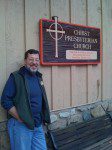
22 Dec PAT BAILEY’S SPIRITUALITY WITH RELIGION
Editor’s note: In his doctoral dissertation, Pastor Pat Bailey of Telluride’s Christ Presbyterian Church is claiming the need for a re-visioning of the Christian church’s theology and its understanding of mission, the need for a more natural, integrative theology and for an earth-focused, contextual approach to mission. This blog is part of a long-running weekly series.
As with Nature, an inter-dwelling view of Spirit retains the mystery that is the otherness of Spirit. One’s perspective on one’s experience of Spirit is not the thing itself and is arrived at inter-subjectively. When one encounters Spirit they are encountering the inexpressible mystery of the Other. By this approach to Spirit, one cannot say whether Spirit exists, but only that Spirit ex-ists in the perspectives of humanity’s imaginative discourse as reflections on humanity’s experiencing. This distinguishing between ex-istence and existence, between perspective and the thing itself, is no longer reserved for questions of religious validation but is applied to all things within the experience of the human subject. Questions of reality then depend upon the phenomenon within human experience and the long history of perspectives on that phenomenon.
Spirit, then, is one of many ways that Christian scripture and tradition has attempted to speak of the experiencing of divine presence in personal and communal contexts. Within that tradition, perspectives on Spirit range from natural elements (air, water, fire) to breath of life, to earthly creatures, to principle of wisdom, to internal counselor, to abiding presence of Christ, to inspirer of scripture, to inciter of community, to hypostasis within Trinity. Within Hebrew and Christian scripture there is no single view of Spirit, but a development of views and counter-views in conversation with the experience of persons and communities and their historical context.
It is important to note, though, that all the perspectives on God and Spirit contained in the Hebrew and Christian scriptures are premodern. They represent particular worldviews in the history of worldviews, and from their location they could not see those perspectives that developed beyond their historical context. This evaluation in no way invalidates their perspective. It simply requires that their perspective be located.
The perspective on Spirit demonstrated in the classical trinitarian creeds is predominantly a mythical construct. Mythology typically divides out the various aspects of reality and identifies the boundaries of their relationships. In mythology, God and Spirit are indeed seen as entirely separate entities from Nature. The further persons go in the stages of development, however, the more integrative becomes their worldview and the more integrative becomes their perspective on Spirit. Perspectives on Spirit become so integrated with perspectives on Nature that it may indeed become difficult or impossible to differentiate the two.
This figuring of Spirit and Nature is beyond the categories of theism, pantheism, and panentheism. In interdwelling, Spirit ex-ists within Nature and Nature ex-ists within Spirit. So, the difficulty of doing theology or speaking about Spirit in a postmythical, postmetaphysical, and postmodern world is apparent. Theologians like Mark Wallace, then, can boldly speak about a reverence, love, and even worship toward Nature in a new context that does not set Nature against God or God against Nature.



Sorry, the comment form is closed at this time.